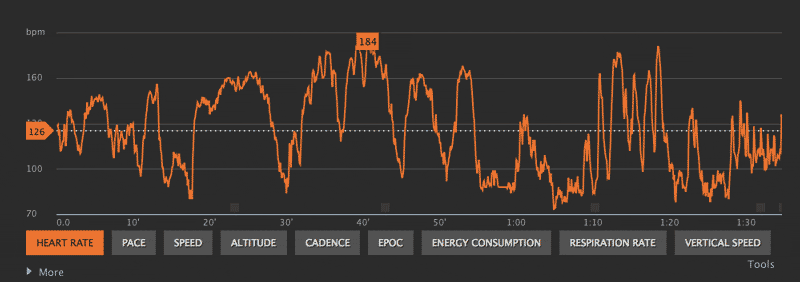
By Carl Valle
Ask nearly any coach if they do tempo runs for speed and power athletes, and they not only say yes but also usually point to the idea that it helps recovery. I have spent over ten years asking what 1,000-2,000 meters of easy running do to the body, and I have still not figured out what exactly light intervals do with very explosive athletes. Some of my first writings on training were touting low-intensity work, and the information provided was helpful but still too vague to help refine a training program. Running programs for recovery are popular. Unfortunately, most of them are poorly applied and not rooted in drug-free science, and they create overtraining syndromes. In this article, I will cover several training theories, dig into the sports science, and attempt to apply a pragmatic overview of what can potentially help athletes.

Figure 1: Above is the screenshot of a workout using the Suunto Ambit GPS watch after the data is uploaded. Coaches can capture heart rate data and see how the physiological response to running and practice inexpensively without a lot of effort. Tempo training should be as precise as possible to keep power athletes fresh and fit.

You Use Tempo Running as a Recovery Workout
Active recovery is a very foggy area in the scientific research since what constitutes actual recovery and the actual workout conjures up different things to different people. Most coaches are familiar with the Easy/Hard approach of alternating hard workouts with easier workouts to keep athletes fresh and able to come back with great effort. The idea of training improving recovery from workouts is a bit of a misnomer, if you think about. The most important two variables related to recovery from training are time and nutrients. Light workouts feel great a day after because they are not back-to-back hard sessions, and this is more relative than absolute. Acutely, another workout may not help recovery more than passive rest, but in the long run, fitness does help an athlete handle the overall stress on the body. Therefore, in reality, tempo running and light training does not help muscles and tendons repair as much as it prevents overload by restricting intensity.
I have argued that tempo running may help by increasing blood flow to the areas that have been strained for lymphatic benefit, but the optimal dose is difficult to estimate after a speed session. Training may have the best sport science support now in 2014, but it’s still not an exact science. An athlete, after speed sessions, technically has microtrauma to the tissues, rendering the body limited the next day. Additional running at slower velocities, while easier, is still pounding on the body when you are doing kilometers of work in a compromised state. Again, it’s not that the workout is that hard; it’s just that the body after maximal and supra-maximal effort is not in a position to do much besides passive rest. Sometimes, a day off or a pool workout should be employed after heavy work, and general fitness is not going to help with any race finishing unless a body composition problem exists or one is extremely deconditioned. Tempo running may develop enough capacity to handle heavy training phases and very deep loading weeks, so general fitness should not be eliminated.

You Don’t Do Enough Running Volume
Speed and power athletes don’t need to do massive volumes, but they do need more than 500 meters of running. The research is not clear about the necessary, specific protocol in creating adaptations that are favorable changes. The key is to improve the fitness of the athlete without compromising speed and hormonal profiles, and conditioning must have a purpose. Tempo running does help with many adaptations morphologically (changes to structures of the body) and biochemically to the cells, but it must be to help increase the ability to train over weeks and improve durability.
The most conventional approach to looking at volume is to treat tempo running as a total distance approach instead of time in an aerobic activity. Exact calculations of tempo running are difficult since even heart rate monitoring is limited, but constant exposure to low-level fatigue encourages adaptation. Using TRIMP methods and other estimates of work is nice, but volume should be replaced by a better term, like total output. Additional factors like density, relative effort, percentage at cruising speeds, and countless variables can answer the tough questions coaches should be asking.
I believe 15 minutes of work is the minimum aerobic contact time in creating a small fitness stimulus. Add warm-ups and active mobility routines, and then we have a longer period of conditioning; not much is needed to see a change. In 15 minutes, we should see 1800-2000 meters of work if you are trying to make a change at the cellular level. The density of work has to be high enough that the body is in a constant state of deficit but not too hard that the aerobic strain can be felt at the muscular and tendon level. A good rule of thumb is tempo work challenges the heart and lungs but rests the joints and tissues. Longer workouts in the pool can help, and medicine ball circuits and other options can extend the aerobic challenge without increasing breakdown of the body.

Your Tempo Speeds and Distances are Inappropriate
Your running speed and repetition distance depend on many factors. Pure speed athletes may benefit from distances of 100m or less, and track athletes, especially 400m-long sprinters, can do far more and longer runs. A simple guideline is that the more running an athlete does continuously in a game, the longer runs they should do in practice. For example, a football player may participate in 50-60 snaps or plays in one game, but his distances may be closer to 5-15 yards per play. Why football players are doing 300-400m of continuous runs is questionable, but 110y strides make sense with larger athletes that still need to cover ground, but not continuously.
Another, less talked about, challenge is how to accelerate into upright running from a stationary starting point. Some programs accelerate very hard for 7-10 steps and “ride the glide,” while others are gradual. No matter what one prefers, everyone has to accelerate when doing tempo, and the distance one is running determines the distribution of work done. For example, a good athlete can accelerate for 50 meters, so repeating 50-meter runs as tempo is not a very steady state. A soccer player doing repeat 200-meter and 300-meter runs at a decent clip is accelerating 15-25% of the time—something to think of when doing repeat work.
The speed of tempo running is an enigma, and the community has wildly accepted arbitrary speeds based on 100-meter personal records. This is insane, and I made the mistake of following this approach for years until I was able to start looking at sports medicine and physiological monitoring more. Seventy-five percent of a personal record or even slower has no purpose in modern track or sports training. Here are several reasons:
- The 100-meter personal record time is only during peak form in the late summer on average, so using that time in the fall is inappropriate.
- One-hundred-meter times on Mondo surfaces versus grass make percentages close to 75% arbitrary.
- Tempo running after speed work is usually difficult to perform because of post-training fatigue and soreness.
A wiser approach is to look for physiological adaptations, create a range from minimum effective dose to maximally safe dose with total running, and determine the running speeds keep general ground contacts sharp.
Volume is a product of distance, density, and intensity for the most part. It’s safe to say 50-70% peak velocity athletes are running on grass and are keeping exposed to aerobic activity 30-80% of the duration of the workout. Finally, the total travel distance is 2,000-4,000 meters 2-3 times a week, making a large possible arrangement of workouts that need to be tailored per athlete.
How much should one do? A little trial and error exists here because every system is different, and every athlete is unique. Some progressions and patterns of increasing demand are available now, and the best idea is to add distance every 3-4 weeks. Increasing the length of the run while maintaining total distance is also a progression because the density of work may increase a bit. Countless variations of increasing the demand are possible; the goal is to make the changes gradual and smooth.

You Don’t Rest Properly Between Sets and Reps
Precision rest periods compliment the work being done and failing to rest properly can make or break a workout. Not resting long enough will make the workout too hard and deplete the body, and resting too long ruins the main purpose of the runs. Two distinct rest periods with tempo running are the rest between sets of runs and between each repetition. Some coaches have rest-to-work ratios with time, some use heart rate recoveries, and some use walking distance. All three should be considered.
The same rules and needs for accurate speed measurement apply to rest precision. Deciding to rest 30 seconds instead of 45 seconds is a much different beast when doing repeat 200m runs on the grass. I have done several experiments to see how a 20- and even 10-second difference matters. I have used splits from Freelap for years with various monitoring solutions, and time of rest matters. The goal of the rest periods is to create a precise and specific challenge to the body, and rest periods must be adhered to in order to get the adaptations cited in the research and sport science experiments with athletes.
The hardest area to manage is not so much how fast athletes go, as they will make the speed, but rest periods are sometimes abused by a casual attitude. For example, if an athlete is doing repeat 100s and rests 40 seconds instead of 30, does it matter? Of course it does, physiologically. Therefore, when an athlete takes longer rests between sets and does not get back in time, the entire workout may be compromised. The work and rest parameters are harmonious and need to be strictly enforced or the workouts become a different animal.

You Don’t Use Physiological and Biochemical Monitoring
A good audit of the program is to add physiological and biochemical monitoring to the training data. Any coach worth his or her salt will get the meat of the program done properly first before worrying about the physiological estimations or training. Aerobic fitness can be estimated using field tests, but daily readings of resting HR coupled with heart rate variability. Supporting physiological monitoring is the use of biochemical tests such as hematocrit, hemoglobin, and iron biomarkers. Hormonal benchmarks such as free testosterone to cortisol are great ways to ensure tempo work is not interfering with the entire training process.
The use of lactate tests and heart rate monitors during training is geared more for endurance athletes, but advanced coaches and athletes are known to look at how their abilities are improving when many of the same workouts are repeated throughout the year. Over the past ten years, I have found that keeping the velocities the same in running is more helpful than trying to get faster to match a percentage of one’s 100-meter time or similar, because comparison is easier. For elite sprinters running 10.2 or faster, 75% of one’s personal best is too fast to recover from. If tempo is for facilitating recovery, you can’t think about recovery workouts for tempo runs! I find “Crisp Jogging” a better option for speed athletes because running mechanics is sharp, but the pounding is minimal. Athletes don’t overstride, and using HR monitors can help to see whether athletes are drawing from reserves to maintain running speed and form.
Concluding Remarks on Tempo Tunning
Tempo runs are a staple in many programs for all athletes, not just sprinters. Coaches tend to overestimate the value of tempo running for recovery and underestimate the strain of extra running. Making sure the runs start gradually and are precisely calibrated for just the right dose, because this can mean the difference between improvement during the season or injuries and poor performance. Tempo running should feel better leaving the workout and be just enough to stoke the fires of maintaining fitness, but not lead to overuse syndromes or poor biological adaptations. In strength and conditioning, they use the idea of treating the lighter weights like they are heavy and the heavy weights like they are light; this applies to tempo training. Treat the easy workouts like they are just as important as speed workouts to ensure one does not overlook a big part of most programs.
[mashshare]References
Billat LV (2001) Interval training for performance: a scientific and empirical practice. Special recommendations for middle- and long-distance running. Part I: aerobic interval training. Sports Med 31:13–31
Curtis BM, O’Keefe JH Jr (2002) Autonomic tone as a cardio- vascular risk factor: the dangers of chronic fight or flight. Mayo Clin Proc 77:45–54
Tordi N, Belli A, Mougin F, Rouillon JD, Gimenez M (2001a) Specific and transfer effects induced by arm or leg training. Int J Sports Med 22:517–524
Wasserman K (1986) The anaerobic threshold: definition, physio- logical significance and identification. Adv Cardiol 35:1–23
Please share this article so others may benefit.



Carl,
Nice article, I like “Coaches tend to overestimate the value of tempo running for recovery and underestimate the strain of extra running”, as well as “Therefore, in reality, tempo running and light training does not help muscles and tendons repair as much as it prevents overload by restricting intensity”. I would still argue in favour of another day or two of rest between high intensity speed if possible, or maintaining a regular cross training approach ( low rep weights 75%-80% max for example). In my experience as a 100m sprinter, sessions of slow running have done more damage than good. The only time I think they are of value is in certain injury cases, but in others staying high intensity or doing nothing is better. I cannot agree that there is any aerobic condition benefit to a short sprinter, and that physiological changes over a season and time serves any real purpose, maybe to 400m runner but that is also debatable and maybe more variable with the particular athlete. I postulate that most sprinters will benefit from an avoidance of session that have a higher volume of low intensity, in favour of a reduced total volume, over time more frequency of speed training may be of benefit. But we should never think that tempo type session have an equal importance as bread and butter flat out speed training does.
Cheers
Great article coach! Are you currently working with athletes? If so I would love to schedule a session sometime in the near future.
Excellent article. I totally agreed